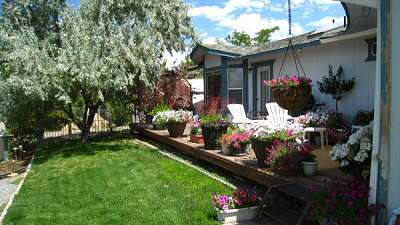What's
wrong with this picture?
Here is the
history as I understand it, bearing in mind that I have not paid much
attention at all
to the boondoggle which has been going on for several years. This is
probably not entirely factually
correct but it makes for a good story anyway.
Some ten years ago
when Las Vegas decided to build a family oriented theme town, Reno
dismissed the
idea as one of the stupider ploys to get more tourist dollars. We all
know what happened and once again Reno was left in the
dust.
Somewhere further
down the road and losing tourist dollars to Las Vegas and the Indian
casinos, Reno
decided it needed to do something really special to attract more
tourism to the area.
A brilliant scheme
was conceived to construct what was to be the largest spanning bridge
of its type
in if not the world, the United States. This bridge was to be
constructed as part of the Highway 395 bypass from Reno to
and through Carson City.
Engineering plans
were drawn up and a constructor was chosen to build the bridge. The
city watched
with bated breath as the first pilings were sunk into the ground. Many
photographers and reporters
were on hand over the weeks to witness the beginning of this
engineering wonder.
Several
months later construction stopped and after noticing no progress, I
decided to ask around to see what was going on. Turned out
the
constructor backed out of the job. Now why would a contractor
back out of a job which would end up being the engineering wonder of
Reno, if not the world. They must have had a good reason.
They did.
The
constructor's own engineers upon examining the job in detail concluded
that while they believed engineering was sound, they did not believe
they could construct the bridge span safely. Human life would be at
risk.
Now how could that
possibly be?
The
reason was the gale-force winds which routinely blow through the
valley, overturning semi's that didn't heed the wind advisories. Wind
coming through valley between the two hills supporting the the bridge
span could create a funnel effect, amplifying already windy conditions
and imperiling the safety of the construction crews.
This is why you
don't take shelter from a tornado under a bridge. Same principle.
The
constructor backed out of the job and there the bridge pilings sat for
well over a year while the city of Reno scratched their collective
heads over what to do next.
What happened next
was an astounding leap of logic.
If wind was the
problem, why not remove the wind.
What
if the area below the bridge was filled with dirt or some other filler
material negating the wind factor? Would this not work?
I
suppose at this point I could mention the obvious and point out that
backfilling the space between two hills sort of negates the purpose
of having a bridge in the first place.
Some
months later Reno decided that backfilling under the bridge was the way
to go but they neglected to consider the environmental impact of such a
decision. Environmentalists were quick to point out that the
area
between the two hills was a natural waterway for spring runoff and
blocking that would create a lake on the other side of the hill, drying
up the Carson Valley.
Was the city prepared to create not only a bridge, but a dam as
well?
A flurry of
lawsuits were threatened should Reno decide to pursue their latest plan.
Some months later
an agreement was reached whereby the new contractor would erect a
temporary
barrier under the
bridge, allowing the safe completion of same.
The barrier would
be removed upon completion of the bridge, revealing Reno's 8th wonder
of the world in all its glory.
This
started out as costing somewhere in the neighborhood of 350
million. Estimates range as high as 2 billion to complete.
The picture above
shows the bridge in its current state, three years later.
Small towns.........gotta love'em
|





















